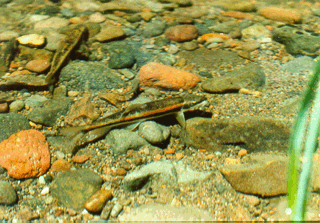Modoc Sucker
-
Scientific NameCatostomus microps
-
NativeYes
-
Identification
 Modoc sucker, spawning. Photo by Stewart Reid, Western Fishes, Ashland, OR.
Modoc sucker, spawning. Photo by Stewart Reid, Western Fishes, Ashland, OR.- Small sucker: usually less than 16 cm SL, maximum 28 cm SL
- Short head (TL = 4-5x head length), small eyes
- Subterminal mouth with fleshy lips
- Upper lip has 2-4 continuous rows of papillae
- Lower lip has deep medial notch, 5-6 rows of papillae, 1 row connects two halves of lower lip
- Coloration: deep gray to greenish brown, yellow to white underside
- Breeding males: orange-red lateral band, orange fins, tubercles on body and fins
- Breeding females, less colorful, lack tubercles
- Lateral line scales (small): 79-89
-
Life History
Modoc Suckers inhabit the cool (<25°C) pools of headwater streams that usually have high spring flows and low summer flows. Favorable streams have moderate gradients with large mud or rock bottomed pools where the Suckers can seek refuge during summer. Within a pool the younger fish tend to stay in shallow water while larger fish seek cover in the deepest holes. Modoc Suckers are commonly found in association with Rainbow Trout, Speckled Dace, Pit-Klamath Brook Lampreys, California Roach, and Pit Sculpin. Their populations may be adversely affected by the presence of predators like Pikeminnow and Brown Trout. Modoc Suckers feed primarily on detritus and algae, at which they are adept, though they may also feed on insect larvae and crustaceans found on soft substrates and aquatic vegetation. They undergo the most rapid growth during their 1st year and typically don’t exceed 15 cm SL in a 4 year life span (5 years max.). Modoc Suckers reach sexual maturity at age 3 and have a relatively high fecundity for their body size. When snow-melt increases flows in mid-April to early June, Modoc Suckers move up into tributary streams where water temperatures are in the range of 13-16°C. Spawning males arrive at gravelly riffles first and await the females. From mid-morning to late afternoon the females release some 6,400 to 12,600 eggs while 2-3 males simultaneously release their milt. The fertilized eggs fall into the spaces and crevices of the substrate where they incubate.
-
Links to Other ResearchN / A
